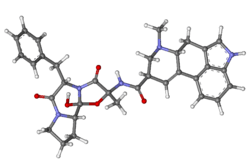Ergotamine
 | |
 | |
| Clinical data | |
|---|---|
| Trade names | Cafergot, Ergomar |
| AHFS/Drugs.com | Monograph |
| Pregnancy category |
|
| Routes of administration | Oral |
| ATC code | N02CA02 (WHO) |
| Legal status | |
| Legal status |
|
| Pharmacokinetic data | |
| Bioavailability |
Intravenous: 100%,[1] Intramuscular: 47%,[2] Oral: <1% [3] (Enhanced by co-administration of caffeine [1]) |
| Metabolism | Hepatic [2] |
| Biological half-life | 2 hours [2] |
| Excretion | 90% biliary [2] |
| Identifiers | |
| |
| CAS Number |
113-15-5 |
| PubChem (CID) | 8223 |
| IUPHAR/BPS | 149 |
| DrugBank |
DB00696 |
| ChemSpider |
7930 |
| UNII |
PR834Q503T |
| KEGG |
D07906 |
| ChEBI |
CHEBI:64318 |
| ChEMBL |
CHEMBL442 |
| ECHA InfoCard | 100.003.658 |
| Chemical and physical data | |
| Formula | C33H35N5O5 |
| Molar mass | 581.66 g/mol |
| 3D model (Jmol) | Interactive image |
| |
| |
| | |
Ergotamine is an ergopeptine and part of the ergot family of alkaloids; it is structurally and biochemically closely related to ergoline. It possesses structural similarity to several neurotransmitters, and has biological activity as a vasoconstrictor.
It is used medicinally for treatment of acute migraine attacks (sometimes in combination with caffeine). Medicinal usage of ergot fungus began in the 16th century to induce childbirth, yet dosage uncertainties discouraged the use. It has been used to prevent post-partum hemorrhage (bleeding after childbirth). It was first isolated from the ergot fungus by Arthur Stoll at Sandoz in 1918 and marketed as Gynergen in 1921.[4]
Mechanism of action
The mechanism of action of ergotamine is complex.[5] The molecule shares structural similarity with neurotransmitters such as serotonin, dopamine, and epinephrine and can thus bind to several receptors acting as an agonist. The anti-migraine effect is due to constriction of the intracranial extracerebral blood vessels through the 5-HT1B receptor, and by inhibiting trigeminal neurotransmission by 5-HT1D receptors. Ergotamine also has effects on the dopamine and norepinephrine receptors. Its side effects are due mainly to its action at the D2 dopamine and 5-HT1A receptors.[6]
Biosynthesis
Ergotamine is a secondary metabolite (natural product) and the principal alkaloid produced by the ergot fungus, Claviceps purpurea, and related fungi in the family Clavicipitaceae.[7] Its biosynthesis in these fungi requires the amino acid L-tryptophan and dimethylallyl diphosphate. These precursor compounds are the substrates for the enzyme, tryptophan dimethylallyltransferase, catalyzing the first step in ergot alkaloid biosynthesis, i.e., the prenylation of L-tryptophan. Further reactions, involving methyltransferase and oxygenase enzymes, yield the ergoline, lysergic acid. Lysergic acid (LA) is the substrate of lysergyl peptide synthetase, a nonribosomal peptide synthetase, which covalently links LA to the amino acids, L-alanine, L-proline, and L-phenylalanine. Enzyme-catalyzed or spontaneous cyclizations, oxygenations/oxidations, and isomerizations at selected residues precede, and give rise to, formation of ergotamine.[8]
Drug uses
Ergotamine produces vasoconstriction peripherally as well as damages the peripheral epithelium. In high doses, ergotamine is conducive to vascular stasis, thrombosis, and gangrene. It can increase uterine contractivity and occasionally is used therapeutically immediately post-partum to decrease uterine bleeding. See also ergometrine.
Ergotamine continues to be prescribed for migraines. The common form of prescription is Cafergot which is a combination of caffeine and ergotamine.
Contraindications include: atherosclerosis, Buerger's syndrome, coronary artery disease, hepatic disease, pregnancy, pruritus, Raynaud's syndrome, and renal disease.[9]
Availability and dosage
In the United States, ergotamine is available as a suppository, a sublingual tablet, and a tablet, sometimes in combination with caffeine. The suppository is available under the brand name Migergot, which contains 2 mg of ergotamine with 100 mg caffeine. The sublingual tablet is available under the brand name Ergomar and contains 2 mg of ergotamine. The combination tablet in combination with caffeine called Cafergot contains 1 mg of ergotamine and 100 mg of caffeine.[10]
This preparation may be used immediately following the aura/onset of pain to abort the migraine. For the best results, dosage should start at the first sign of an attack.[11]
Side effects
Side effects of ergotamine include nausea and vomiting. At higher doses, it can cause raised arterial blood pressure, vasoconstriction (including coronary vasospasm) and bradycardia or tachycardia. Severe vasoconstriction may cause symptoms of intermittent claudication.[12]
See also
- Dihydroergotamine, a semi-synthetic form used as an abortive migraine treatment
- Ergotism
- Ergometrine
References
- 1 2 Sanders, SW; Haering N; Mosberg H; Jaeger H (1986). "Pharmacokinetics of ergotamine in healthy volunteers following oral and rectal dosing". Eur J Clin Pharmacol. 30 (3): 331–4. doi:10.1007/BF00541538. PMID 3732370.
- 1 2 3 4 Tfelt-Hansen P, Johnson ES. Ergotamine. In: Olesen J, Tfelt-Hansen P, Welch KM, editors. The headaches. New York: Raven Press; 1993. p. 313–22.
- ↑ Ibraheem JJ, Paalzow L, Tfelt-Hansen P. Low bioavailability of ergotamine tartrate after oral and rectal administration in migraine sufferers. Br J Clin Pharmacol 1983; 16: 695–9.
- ↑ AJ Giannini, AE Slaby. Drugs of Abuse. Oradell, NJ, Medical Economics Books, 1989.
- ↑ Walkembach J, Brüss M, Urban BW, Barann M (October 2005). "Interactions of metoclopramide and ergotamine with human 5-HT3A receptors and human 5-HT reuptake carriers". Br. J. Pharmacol. 146 (4): 543–52. doi:10.1038/sj.bjp.0706351. PMC 1751187
 . PMID 16041395.
. PMID 16041395. - ↑ Tfelt-Hansen P, Saxena PR, Dahlof C, Pascual J, Lainez M, Henry P, Diener H, Schoenen J, Ferrari MD, Goadsby PJ (2000). "Ergotamine in the acute treatment of migraine: a review and European consensus". Brain. 123: 9–18. doi:10.1093/brain/123.1.9. PMID 10611116.
- ↑ Pharmacognosy of Ergot
- ↑ Schardl CL, Panaccione DG, Tudzynski P (2006). "Ergot alkaloids--biology and molecular biology". Alkaloids Chem. Biol. The Alkaloids: Chemistry and Biology. 63: 45–86. doi:10.1016/S1099-4831(06)63002-2. ISBN 978-0-12-469563-4. PMID 17133714.
- ↑ AJ Giannini. Biological Foundations of Clinical Psychiatry. Oradell, NJ. Medical Economics Puclishing Co., 1986.
- ↑ FDA Orange Book http://www.accessdata.fda.gov/scripts/cder/ob/docs/tempai.cfm
- ↑ http://dailymed.nlm.nih.gov/dailymed/lookup.cfm?setid=b4a06de6-f837-43a8-ae7a-aadb38dd2a7d#DA
- ↑ "Medihaler Ergotamine". drugs.com. Retrieved 2016-05-20.